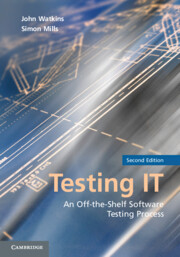Book contents
- Frontmatter
- Contents
- Foreword to the Second Edition by Geoff Thompson
- Foreword to the First Edition by Maurice Rosenburgh
- Acknowledgments
- 1 Introduction
- PART 1 THE TRADITIONAL TESTING PROCESS
- PART 2 THE TESTING PROCESS IN THE REAL WORLD: ILLUSTRATIVE CASE STUDIES
- PART 3 THE APPENDICES
- References
- Glossary
- Index
Foreword to the Second Edition by Geoff Thompson
Published online by Cambridge University Press: 03 May 2011
- Frontmatter
- Contents
- Foreword to the Second Edition by Geoff Thompson
- Foreword to the First Edition by Maurice Rosenburgh
- Acknowledgments
- 1 Introduction
- PART 1 THE TRADITIONAL TESTING PROCESS
- PART 2 THE TESTING PROCESS IN THE REAL WORLD: ILLUSTRATIVE CASE STUDIES
- PART 3 THE APPENDICES
- References
- Glossary
- Index
Summary
So what is this testing thing then?
A question that I and many other aspiring software testing professionals get asked frequently. We try to explain, and watch the questioner's eyes glaze over as he or she furtively starts looking around to find a reason to step away or change the subject.
Isn't it strange that this happens? Is it that the explanation is simply incomprehensible by any sane person, or is it that software testers themselves need to understand in simple terms what it is they do?
I can add my own personal perspective on this issue; I help organize the British Computer Society Specialist Group in Software Testing (BCS SIGiST), and I am regularly surprised by two things: first, 70% of the attendees have never attended any form of networking meeting before, and second (and perhaps more important), none of the attendees read any of the many software testing books that exist.
Having had the opportunity to discuss this with many of the attendees, it is clear that the reason for this is the content of the typical testing book – it's just too complex for them to get their teeth into and understand. What is needed is a straightforward, simple-to-read, and simple-to-use testing book.
When the first edition of Testing IT was released in 2001, this changed. For once there was a book that provided a simple overview of what testing was, with straightforward guidance for test practitioners, plus a selection of easy-to-use testing templates.
- Type
- Chapter
- Information
- Testing ITAn Off-the-Shelf Software Testing Process, pp. xiii - xivPublisher: Cambridge University PressPrint publication year: 2010



